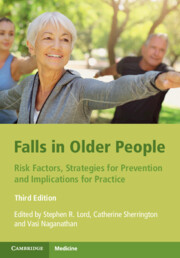Book contents
- Falls in Older People
- Falls in Older People
- Copyright page
- Contents
- Preface
- Contributors
- Part I Epidemiology and Risk Factors for Falls
- 1 Epidemiology of Falls and Fall-Related Injuries
- 2 Postural Stability and Falls
- 3 Gait Characteristics and Falls
- 4 Sensory and Neuromuscular Risk Factors for Falls
- 5 Biomechanics of Balance and Falling
- 6 Foot Problems, Footwear, and Falls
- 7 Brain Function and Falls
- 8 Impaired Cognition and Falls
- 9 The Psychology of Fall Risk: Fear, Anxiety, Depression, and Balance Confidence
- 10 Medical Risk Factors for Falls
- 11 Medications as Risk Factors for Falls
- 12 Environmental Risk Factors for Falls
- 13 Fall Detection and Risk Assessment with New Technologies
- 14 Fall Risk Screening and Assessment
- 15 The Relative Importance of Fall Risk Factors: Analysis and Summary
- Part II Strategies for Prevention
- Part III Implications for Practice
- Index
- References
3 - Gait Characteristics and Falls
from Part I - Epidemiology and Risk Factors for Falls
Published online by Cambridge University Press: 04 November 2021
- Falls in Older People
- Falls in Older People
- Copyright page
- Contents
- Preface
- Contributors
- Part I Epidemiology and Risk Factors for Falls
- 1 Epidemiology of Falls and Fall-Related Injuries
- 2 Postural Stability and Falls
- 3 Gait Characteristics and Falls
- 4 Sensory and Neuromuscular Risk Factors for Falls
- 5 Biomechanics of Balance and Falling
- 6 Foot Problems, Footwear, and Falls
- 7 Brain Function and Falls
- 8 Impaired Cognition and Falls
- 9 The Psychology of Fall Risk: Fear, Anxiety, Depression, and Balance Confidence
- 10 Medical Risk Factors for Falls
- 11 Medications as Risk Factors for Falls
- 12 Environmental Risk Factors for Falls
- 13 Fall Detection and Risk Assessment with New Technologies
- 14 Fall Risk Screening and Assessment
- 15 The Relative Importance of Fall Risk Factors: Analysis and Summary
- Part II Strategies for Prevention
- Part III Implications for Practice
- Index
- References
Summary
Habitual upright walking is a characteristically human trait that provides a challenging set of physiological challenges. When standing erect, two-thirds of the body’s mass is located two-thirds of body height from the ground, precariously balanced on two narrow legs with the only direct contact with the ground provided by the feet [1]. Such a structure challenges the basic principles of mechanical engineering and requires a highly developed postural control system to ensure that the body remains upright. However, in order to progress forwards, it is necessary to repeatedly initiate a forward fall and then ‘re-capture’ this momentum by the appropriate placement of the leading limb. The potential for a loss of balance when performing an apparently simple task such as walking is considerable. It is therefore not surprising that between 50 and 70% of falls in older people occur when walking [2–4]. The aim of this chapter is to provide an overview of the literature pertaining to gait patterns in older people and their relationship to falls. Specifically, this chapter will address gait characteristics during level walking, when distracted by secondary tasks, when stepping over, avoiding, and approaching obstacles, during turning, stair walking, and the ability to respond to trips and slips.
- Type
- Chapter
- Information
- Falls in Older PeopleRisk Factors, Strategies for Prevention and Implications for Practice, pp. 51 - 86Publisher: Cambridge University PressPrint publication year: 2021
References
- 1
- Cited by



